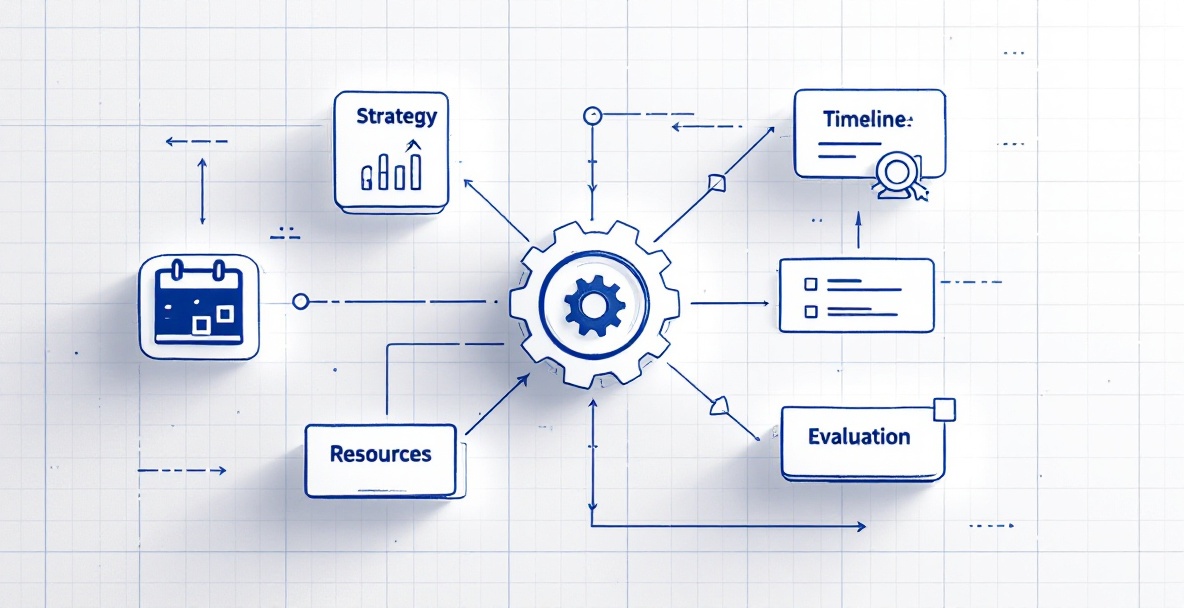Uncovering what drives your competitors' success in search rankings isn't just about keeping up—it's about finding opportunities they've missed and leveraging them to your advantage. At SEO Tuts, we've found that organizations who systematically analyze competitor strategies typically outperform those who operate in isolation. This comprehensive guide will walk you through the process of reverse-engineering competitor success, from technical foundations to conversion optimization techniques.
Understanding the Competitive SEO Landscape

The digital battlefield requires not just awareness of your competitors but a deep understanding of what makes them successful. Effective competitive analysis helps you avoid reinventing the wheel while providing a benchmark for your own performance.
Why Competitor Analysis Matters
Competitive analysis functions as both a shortcut and a roadmap. By studying successful competitors, you can identify proven strategies in your specific market rather than starting from scratch. This process reveals gaps in your approach and uncovers opportunities competitors have overlooked. For instance, when working with e-commerce clients, we often find that examining competitor product page structures reveals valuable insights about feature highlighting and technical specifications that drive conversions.
The most valuable aspect of competitor analysis is perspective—it helps you see your strategy objectively by comparing it against others in your space. This comparative framework allows you to prioritize improvements based on real-world impact rather than theoretical best practices. Additionally, tracking competitors over time helps you anticipate industry shifts before they become mainstream.
Key Performance Indicators
Meaningful competitor analysis starts with measuring the right variables. Traffic volume provides a baseline, but deeper metrics tell the real story. Look at organic visibility trends across different search verticals (informational, transactional, local) to understand where competitors focus their efforts. Tools that track keyword rankings across defined segments can reveal whether competitors prioritize top-of-funnel content or bottom-funnel conversion pages.
Engagement metrics like bounce rate, time on site, and pages per session help evaluate how effectively competitors satisfy user intent. While these metrics aren't directly visible, approximations from third-party tools provide useful insights. Market share analysis—the percentage of total available search traffic captured for targeted keywords—offers perhaps the most valuable competitive metric, revealing not just rankings but actual business impact.
Remember that metrics without context are meaningless. Track not just the numbers but what actions preceded significant changes in competitor performance.
Technical Analysis of Competitor Websites

A competitor's technical foundation often reveals the true sophistication of their SEO approach. Technical excellence creates a multiplier effect that enhances every other optimization effort.
Technical SEO Audit Framework
Begin with a crawl-based analysis of competitor sites using tools that simulate search engine behavior. Focus initially on crawlability factors: examine robots.txt files for directional insights about what competitors consider important or sensitive. Review XML sitemaps for organizational clues and compare sitemap structure against actual indexation patterns to identify potential gaps or priorities.
Analyze HTTP status codes across competitor sites to detect patterns in redirect strategies and error handling. Are they actively pruning content or preserving legacy URLs? Check HTTP headers for implementation details that suggest advanced technical knowledge, such as cache control settings or content security policies that might impact performance.
Schema markup implementation often separates sophisticated competitors from basic ones. Examine how competitors structure data for rich results and what entities they choose to highlight. This technical choice reveals which business aspects they consider most valuable for search visibility.
Performance Analysis
Site speed has become increasingly critical for both user experience and rankings. Analyze competitor load times through tools that measure core web vitals and identify whether their performance results from technical excellence or compromise.
Look specifically at first contentful paint and largest contentful paint metrics to understand how quickly competitors deliver meaningful content to users. Examine cumulative layout shift scores to gauge stability during page load—a factor increasingly important for mobile users.
Compare server response times across competitors to identify those investing in premium hosting infrastructure versus basic solutions. Performance patterns often reveal resource allocation priorities and technical sophistication more clearly than any public statement.
Structure and Architecture
Information architecture provides insight into how competitors organize their content universe. Analyze URL structures for patterns that reveal taxonomy decisions and content hierarchy. Are they using flat architectures to maximize link equity or deep structures that create topical clusters?
Internal linking strategies often expose content priorities more clearly than stated business goals. Use crawl data to identify the most internally-linked pages in competitor sites—these reveal what they consider most valuable from both user and search engine perspectives.
Pay particular attention to the relationship between mobile and desktop implementations. Examining how competitors handle responsive design or separate mobile experiences can reveal technical constraints or advantages they're working within.
Content and Authority Analysis

While technical foundations matter, content and authority ultimately determine competitive success. This analysis reveals not just what competitors create but how they build credibility around it.
Content Strategy Assessment
Map competitor content against the customer journey to identify coverage patterns and gaps. Are they focusing on specific stages while neglecting others? Download and categorize competitor content by format, word count, frequency, and conversion elements to identify their content investment priorities.
Perform qualitative analysis of top-performing competitor content. What expertise signals do they incorporate? How do they balance promotional content against informational value? Identify content that consistently outranks yours despite similar quality signals—this often reveals hidden authority factors or technical advantages.
The most revealing content analysis comes from tracking publication patterns against ranking improvements. This timeline approach exposes cause-effect relationships between content investments and SEO outcomes far more effectively than snapshot analysis.
Backlink Profile Analysis
Backlink profiles reveal competitive authority-building strategies. Begin with a domain-level comparison of link quantity, quality, and velocity. Then drill down to page-level analysis to identify which specific assets attract links naturally. This often reveals content types you should consider developing.
Categorize competitor backlinks by source type (news sites, industry publications, directories, etc.) to understand their outreach focus. Analyze anchor text distribution to identify whether competitors focus on branded, keyword-rich, or natural variation patterns in their link building.
Look beyond numbers to link context. What story does a competitor tell that attracts coverage? How do they position themselves within the industry conversation? These narrative elements often drive authority more than tactical link building.
Keyword Strategy Evaluation
Competitor keyword targeting reveals market positioning decisions. Map competitor rankings across keyword categories to identify deliberate focus areas versus incidental rankings. Pay particular attention to SERP feature capture—which competitors consistently appear in featured snippets, knowledge panels, or people also ask sections?
Compare keyword difficulty against domain authority to identify areas where competitors might be overreaching or playing it safe. Track cannibalization patterns to see if competitors maintain clean keyword targeting or allow internal competition for terms.
The most valuable insight comes from identifying keywords where competitors rank for related terms but miss specific high-value variations. These adjacency gaps represent immediate opportunities for your strategy.
Conversion and User Experience Analysis

Rankings without conversions deliver ego value but not business results. Understanding how competitors turn visibility into business outcomes completes the competitive analysis picture.
Conversion Optimization
Analyze competitor conversion paths to identify friction points they've eliminated or created. Count clicks required to complete core transactions and compare them against your process. Document call-to-action language, placement, and design patterns that appear consistently across top competitors.
Study competitor form implementations, looking at field requirements, validation approaches, and multi-step versus single-page strategies. Test competitor checkout processes to experience firsthand what customers encounter, noting trust signals, urgency elements, and abandonment prevention tactics.
The most revealing conversion analysis comes from experiencing competitor processes as a customer rather than an analyst. This perspective shift often highlights emotional elements of the journey that data alone misses.
User Journey Mapping
Create side-by-side journey maps comparing your experience against key competitors. Document entry points, navigation patterns, and content sequences for primary user scenarios. Pay particular attention to how competitors handle cross-device journeys and interrupted sessions.
Analyze competitor navigational structures, particularly how they visually prioritize different sections and user paths. Study their implementation of progressive disclosure—how they reveal information complexity gradually rather than overwhelmingly.
The most insightful journey mapping examines non-linear paths. How do competitors handle users who don't follow expected sequences? These edge cases often reveal the true sophistication of user experience design.
Analytics Implementation
Reverse-engineering competitor analytics helps you understand what data drives their decisions. While you can't access their analytics directly, implementation details provide clues. Examine page source code to identify which analytics platforms competitors use beyond the standard Google Analytics implementation.
Look for evidence of event tracking, custom dimensions, and enhanced e-commerce implementations that suggest sophisticated measurement approaches. Check for tag management solutions that indicate organized, governed analytics programs rather than ad-hoc implementation.
Pay particular attention to evidence of testing frameworks and personalization tools, which often indicate mature optimization programs. These advanced implementations reveal competitors who make data-driven rather than intuition-driven decisions.
Implementation Strategy and Action Plan
Analysis without action creates interesting discussions but no competitive advantage. Converting competitor insights into implementation plans requires prioritization and resource planning.
Priority Assessment
Organize competitive insights into three categories: critical gaps (areas where competitors dramatically outperform you), quick wins (easily implementable improvements), and strategic initiatives (larger projects requiring significant investment). This categorization provides a framework for balanced improvement.
Score opportunities based on potential impact, implementation complexity, and resource requirements to create a prioritized roadmap. Avoid the temptation to chase every competitor strength simultaneously—focus on areas where improvement creates meaningful business outcomes.
The most effective prioritization incorporates both defensive moves (closing critical gaps) and offensive strategies (exploiting competitor weaknesses or unaddressed opportunities). This balanced approach prevents purely reactive strategy.
Resource Planning
Break implementation plans into skill-based workstreams with clear ownership and dependencies. Map internal capabilities against requirements to identify where external expertise might accelerate progress. Create specific timelines based on realistic resource availability rather than ideal scenarios.
Develop phased implementation approaches for larger initiatives to deliver incremental value while working toward comprehensive solutions. This approach builds momentum and organizational confidence while managing resource constraints.
The most successful resource planning acknowledges the reality of competing priorities. Rather than assuming dedicated focus, create flexible implementation frameworks that accommodate the organization's other commitments.
Monitoring and Adjustment
Establish baseline metrics before implementation to accurately measure impact. Create dashboards comparing your performance against competitors on key indicators to maintain competitive awareness during implementation. Set specific review points to assess progress and adjust priorities based on competitor responses and changing market conditions.
Develop trigger-based adjustment protocols that automatically flag significant competitor changes requiring immediate attention. This approach balances planned implementation with necessary responsiveness to competitive moves.
The most valuable monitoring frameworks incorporate leading indicators that predict future competitive shifts rather than simply documenting past changes. This forward-looking approach allows proactive rather than reactive strategy adjustment.
Competitive analysis is not a one-time project but an ongoing discipline that continuously informs strategy. By systematically reverse-engineering competitor success while identifying untapped opportunities, you create a foundation for sustainable competitive advantage—not by copying others, but by learning from them and then exceeding their achievements.
Ready to transform competitive insights into actionable SEO strategies? Visit SEO Tuts today to access our comprehensive training on competitive analysis frameworks that turn competitor research into tangible business results. Our step-by-step tutorials will guide you through the entire process, from technical auditing to implementation planning.
Leave a Reply